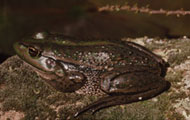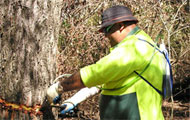- Mt. Canobolas & Lake Canobolas
- Rain & Floods
- Object :: Pluviometer
- Object :: Tipping Bucket
- Object :: Rainfall Records
- Introducing Water in Orange
- Object :: Douglas Pump
- Spiritual Dimensions
- Interview :: Ian Marr
- Object :: Ian Marr Bench
- Interview :: Carl MacKander
- Object :: Baptismal Font
- Object :: Chalices
- Interview :: Mandy Martin
- Wiradjuri People
- Interview :: Joyce Williams
- Object :: Painting by Joanne Reid
- Canowindra Fish Fossils
- Object :: Fossils
- Swamps & Wetlands
- Interview :: Rodney Tonkin
- Interview :: Jill Campbell
- Object :: Willow
Swamps and Wetlands
Orange was named Blackman's Swamp by the early white settlers; an apt name given that much of the land around the city was comprised of swamps, now regarded as wetlands. The dank and eerie environment associated with swamps in horror movies has also contributed to their reputation. Despite wetlands being regarded as worthless in the past, their environmental value is now widely recognised. Wetlands support varied flora and fauna and act as ecological filters that naturally remove pollutants from water.

View Caption
The challenge for urban planners is to ensure that development is carried out sensitively with regard to existing wetlands so that stormwater and pollutants are not carried downstream into bigger waterways.
Waterways conservationists are also concerned about the impact of willow trees on local watercourses. Although willows have long been a feature of district streams and lakes, they are now regarded as a serious environmental hazard. They exclude native flora and fauna, have a high water demand, and can damage riparian zones. Removal is carried out within the city and along Blackman’s Swamp Creek and in the Lake Canobolas Reserve in accordance with best practice methods as specified by the NSW Department of Infrastructure, Planning and Natural Resources.
Stress is also inflicted on district watercourses and their attendant wildlife by competing human activities. While many of the city’s parks and sporting ovals have been built on former swampy land, the waterways themselves are sometimes in danger of over-use. Flora and fauna, especially bird life, can be adversely affected by human activity, and local environmentalists are closely monitoring areas considered to be endangered.
